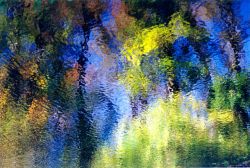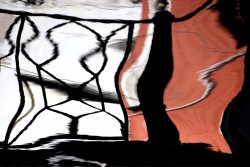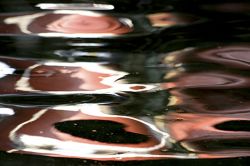"My
earliest photographs were taken of the sound of red. It's hard for me
to describe the sound in musical terms except that it is like a siren
-- not a loud annoying siren but like the Sirens in Ulysses which
neither he nor I could resist."
Photo courtesy of Marcia Smilack
ST.
PETERSBURG - The sky was the color of a capital letter "C," and out in
the bay, above the softly chiming reflections of sailboats, gulls
whirled and swooped, filling the air with calls of mustard and
cinnamon.
This was St. Petersburg on a crisp Saturday in late January, a city
transformed by the kaleidoscopic juxtaposition of sensations known as
synesthesia. Those born into this world live in a realm of colored
numbers, musical reflections and flavored sounds.
People like James Wannerton, who, as a young boy, tasted the divine in a classroom.
"One of my earliest memories was being at school, listening to the
Lord's Prayer and getting flavor after flavor coming in. It was mostly
bacon. It wasn't unpleasant."
Wannerton recently journeyed to St. Petersburg from his native Great
Britain to share his synesthetic experiences at the sixth annual
conference of the American Synesthesia Association. He was joined by
scientists, artists and lay people dedicated to the investigation and
exploration of the phenomenon.
"For me," Wannerton said, "nearly everything has a flavor,
including countries. You'll be happy to know that the United States
tastes like Starbursts. This room, however, tastes distinctly of mashed
carrots. I have no idea why."
While academics debate the cause of synesthesia - whether its roots
lie in the physiology of the mind or the chemistry of it - one thing is
certain: It's all about connections. Connections between sensations,
connections between brain regions and, perhaps most importantly,
connections between individuals.
Though an estimated 2 percent to 4 percent of the population has the
condition, most go through life never realizing others share their
unique perspectives. Met with disbelief or ridicule, they learn not to
discuss the flavor of triangles or the color of Monday.
But that is beginning to change. Michelle Sonntag came all the way from Salt Lake City to find another blue A.
"From what I've read, most people have warm-colored A's, reds and oranges. Apparently blue A's are rare."
A junior at the University of Utah, Sonntag has the most common
manifestation of synesthesia: She sees colors associated with letters
and numbers. Shown a computer screen filled with small d's, she can
instantly spot the errant b, a drop of azure in a sea of green. If the
letter or number is spoken, its color will be different.
"The number 6 is gray when you write it, but yellow when you say it."
As a young child, she assumed everyone experienced the alphabet as
she does. It was not until grade school that she learned the truth.
"I think I was in second grade. I liked the name Jack, and one day
someone asked me why. I said, 'Because Jack is red, and red is my
favorite color.' All the other kids just looked at me like I was crazy."
Carol Steen also felt the sting of rebuke at an early age.
Co-founder of the American Synesthesia Association, she recalls walking
home with a schoolmate one day and mentioning what a beautiful color
pink the letter A was.
"My friend scrunched up her face and said, 'You're weird.'"
A Bad Tooth Glows Orange
Steen also sees colors associated with touch, pain and sound. As a
result, she can usually self-diagnose illnesses long before they become
apparent to others.
"Several years ago, I was at my dentist's during a routine visit. I
knew I was going to be having a problem with one particular tooth
because it had begun to glow orange. I had never mentioned my
synesthesia to the dentist, but I didn't want to have to make a second
visit."
She explained what she was experiencing and the dentist, though skeptical, agreed to check the tooth.
"When he was finished drilling, there was a long pause," Steen
remembered. "I waited with a mouthful of equipment. Finally, he said,
'You were right; the root is dying.'"
Steen has incorporated her synesthetic experiences into her
paintings, capturing in pigment the blooms of color elicited from an
acupuncturist's needle or the moving, gemlike hues of particular
sounds.
For the New York artist, synesthesia has been an overwhelmingly
positive experience, a gift that has enriched her life. Many
synesthetes would agree, but not all. Eric Odgaard, assistant professor
of psychology at the University of South Florida, has spent his career
studying synesthesia. He knows of one Bay area woman who considers her
condition more burden than blessing.
"Imagine a band going off loudly in your ear every time you spoke
to someone. That's her world. Imagine how distracting it would be."
Distractions have always been a part of Wannerton's life. His
version of synesthesia, known as lexical-gustatory synesthesia, is a
rare manifestation of the condition. Sounds and words produce a
corresponding taste; memories are savored like items on a menu.
"My grandmother, who died when I was very young, tasted like Junior
Mints; my grandfather, like big, crumbly cheese. My mother tasted of
ice cream and wafers, and my father of processed peas, which he was
none too pleased about."
The whims of Wannerton's palate have sometimes proved problematic.
"I probably shouldn't tell you this," he confided, "it's a bit
embarrassing. But when I was a teen and beginning to discover girls, I
would only date ones who had pleasant-tasting names. I mean, how
shallow is that? It often got me into quite a bit of trouble. I was
constantly amazed that the girls with the sweetest-tasting names had
the sourest dispositions."
Some believe the improbably melded sensations associated with
synesthesia are the result of the brain's wiring. That neural pathways
normally pruned in early childhood instead remain a dense network,
allowing electrical impulses to leapfrog between regions usually
isolated.
Others suggest a neurochemical source, a breakdown in the
inhibition mechanisms that usually prevent activity in one location of
the brain from triggering a response elsewhere.
Traits, Gifts And Personalities
Although the causes of synesthesia are up for debate, some
generalizations can be drawn. There appears to be a genetic component;
synesthesia often runs in families, Odgaard said. It's more prevalent
in women than men.
Many synesthetes have perfect pitch and can perform impressive
feats of memory. Sonntag, for example, whose father is also
synesthetic, was able to rattle off the first 22 digits of pi when
asked.
"I could have done more," she confessed with a self-deprecating
shrug, "but when I decided to memorize it, that was as far as my
calculator went."
Synesthesia is lifelong. It is involuntary and consistent: The same
stimuli will always produce the same synesthetic response. Synesthetic
experiences are highly memorable and laden with emotional resonance.
Personification is common. Letters and numbers frequently have genders,
personalities and complex interrelationships.
Synesthetic images often have a definite location in space. The
concept of time, for instance, may be experienced as a series of
interlocking spirals that slowly rotate around the individual.
Marcia Smilack, a photographer from Martha's Vineyard, Mass.,
understands the notion of time as something concrete, something that
can be defined in terms of shape and hue.
"I was with a group of synesthetes recently, and we got into a
heated debate about what color the new millennium was. We all agreed
that of course it was yellow," she said with an easy laugh, "but no one
could agree on what shade of yellow. Was it ocher; was it beige; was it
saffron?"
Smilack is a bidirectional synesthete; she both sees what she hears
and hears what she sees. Certain physical conditions also produce
sounds.
"I remember being sick as a very young girl and asking my mother why my fever sang to me."
She first heard the word "synesthesia" in her mid-20s while bobbing
and weaving to the colorful patterns produced by the rhythmic thump of
a Laundromat dryer.
"I thought I was alone, but when I turned around I discovered
another woman had been watching me intently. I was mortified, but she
suggested I might be synesthetic. Turned out she was a graduate student
in psychology and had just read a paper on it."
'It's All Harmony'
Smilack's photography is a snapshot of her synesthetic experience.
Reflections in water produce profound reactions and are the subject of
nearly all of her pictures. She focuses her camera on a lake or stream,
puddle or ocean until the undulating surface elicits a sound. Then she
snaps the shutter.
"It's important that I convey to others the many layers of the
experience, that although it may sound overwhelming, every shape and
texture and color that I see fits in perfectly with the environment.
Everything is precisely where it should be. Nothing is disjointed. It's
all harmony. Everything is connected."
A desire for connection motivated Rachel White to attend the
conference. The Washington, D.C., resident had never before met another
synesthete, though for years she assumed everyone saw the world as she
does.
During her senior year in high school, she and a group of friends started discussing the colors of letters.
"They didn't seem to have a very strong opinion the way I did,"
White recalled. "They were willing to spark a debate about it, but they
had no real opinions. Suddenly I realized I was different."
But for a few days in late January, she was not. During a break
between presentations, she and Sonntag compared experiences.
Inevitably, the discussion led to the shade of the first letter in the
alphabet.
"My A's are blue," Sonntag said.
White nodded with a knowing smile. "So are mine."
And one more connection was made.
Michael Winter can be reached at (813) 259-7510 or mwinter@tampatrib.com.
She Has Their Number
Synesthesia manifests itself in different ways among different
people. For some, images come with sounds; for others, words bring
flavors. One of the manifestations of Michelle Sonntag's synesthesia is
that numbers have colors and distinct personalities.
Here's her description of those personalities:
1 is a baby (obviously) male, sweet-tempered, bald and in a big white diaper (being a white number).
2 is red, female, a bit of a tomboy, loves sports and is not afraid to stand up for herself or those who need it.
3 is an aqua-ish blue, male, young (younger than 2, actually) and very fun-loving, almost to the point of being a prankster.
4 is purple, male and a bit of a nerdy wimp (no offense to the nerds out there). He's smart, but he gets picked on a lot.
5 is gold, female and the one who picks on 4 the most.
She's a bit of a bully, and only 2 can stand up to her to get her off
4's back.
6 is gray, male and kind of lacks personality, but in
a cool way. He's the kind of person who doesn't do anything when you're
watching, but you just know he's about to do something really
fantastic.
7 is green, male and a total trickster. He loves playing around, much to the displeasure of 8.
8 is black (with a touch of blue), male and an authoritarian. He hates disorder, and he's often scolding 7.
9 is the big brother of the group. Orange and male, he
keeps 8 from getting too stuffy and 7 from getting out of control, all
with a happy, fun personality.
10 is 1, but grown up a bit. About 18 years old, he's
the oldest of the 1-10 numbers and an even bigger brother than 9,
though he doesn't interfere much. Interestingly enough, although 1
itself is white, and 0 is an emptier white, in the number 10, 1 turns
black. This also happens in binary code, which is a series of black
ones and white zeroes to me.
Michael Winter
Several noted artists, musicians and writers have been identified as synesthetes. These include painter David Hockney, writer
Vladimir Nabokov and composers Duke Ellington, Franz Liszt, Nikolai Rimsky-Korsakov and
Olivier Messiaen. Nikola Tesla was a synesthete, as was Richard Feynman. Hip-hop producer and musician Pharrell Williams
and Tool bassist Justin Chancellor both have music-color synesthesia.
Several resources are available for those who have synesthesia and would like to learn more or meet others like themselves:
•The American Synesthesia Association is a not-for-profit
organization created in 1995 by Carol Steen and Patricia Lynne Duffy to
provide information to synesthetes and to further research. Its Web
site is www.synesthesia.info.
• www.mixsig.net/nexus/is a forum in which many types of synesthesia are discussed.
•The Blue Cats Synesthesia Resource Center hosts an informative site
with articles, suggested readings and links to other sites. Go to www.bluecatsandchartreusekittens.com.
• In addition, Eric Odgaard, assistant professor of psychology at
the University of South Florida, has spent his career studying
synesthesia and would like to hear from Bay area synesthetes. You can
e-mail him at eodgaard@stpt.usf.edu.
Types Of Synesthesia
Synesthesia can manifest itself in many ways. It is not unusual for synesthetes to experience more than one type.
Grapheme-color synesthesia
Letters or numbers are perceived as having color. It is the most common form of synesthesia.
Ordinal linguistic personification
Letters, numbers, days of the week and months of the year can evoke
detailed personalities. The letter A, for instance, may be perceived as
a kindly mother, protective and nurturing, while the letter B may be an
adolescent boy prone to flights of fancy.
Spatial-sequence, or number form, synesthesia
Numbers, months of the year and/or days of the week are perceived as
having a definite shape and location in space. Tuesday may be pointed
and to the left of Sunday. January may be brown and physically closer
than red July. This form of synesthesia may also manifest itself as a
three-dimensional concept of the year, time being a shape that rotates
around the individual.
Music and sound-color synesthesia
Individuals experience colors and shapes in response to tones and
sounds. This form of synesthesia can also be bidirectional, meaning
that perceptions of sight and touch can produce corresponding sounds.
Lexical-gustatory synesthesia
In this rare form of synesthesia, words produce the sensation of taste in the mouth.











